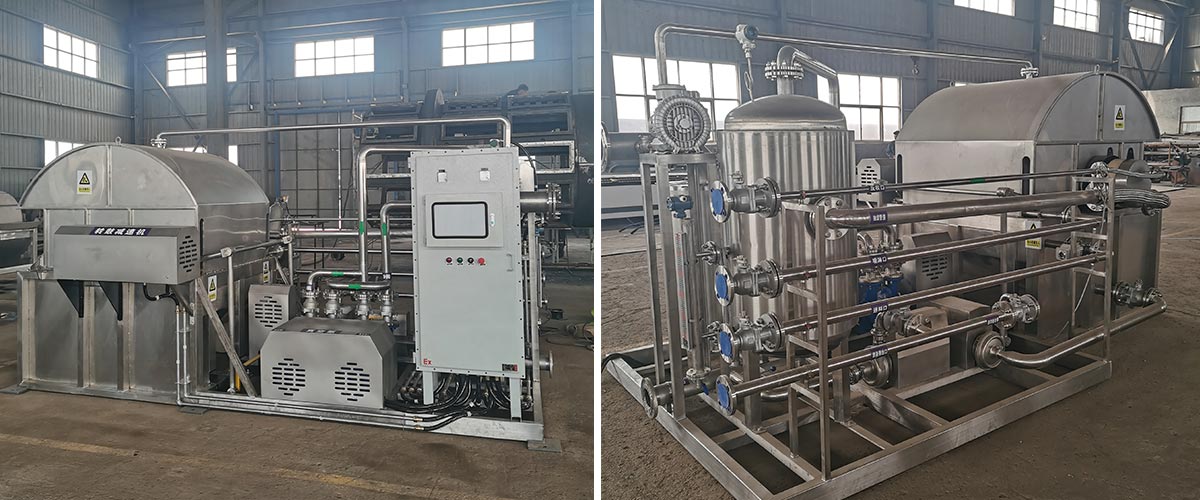The core principle of the rotary vacuum filter lies in utilizing drum rotation and vacuum suction to perform processes such as filtration, washing, and drying across different zones. It is primarily employed for separating solid-liquid mixtures.
Core Advantages
1. Continuous automation for cost reduction and efficiency enhancement: Simultaneously completes the entire process of filtration, washing, drying, and discharge without manual switching operations.
2. High throughput and superior separation efficiency: Large filtration area per unit time combined with stable vacuum suction ensures rapid filtration and uniform cake cutting.
3. Strong adaptability for diverse applications: Adjustable components and parameters accommodate suspension processing requirements across various industries.

Core structure
Structural components | Core functionality |
Rotating drum | The equipment core is covered with filter cloth on the surface and divided into multiple independent fan-shaped chambers internally, which rotate with the transmission system. |
Vacuum system | Providing negative pressure suction is a power source for liquid separation and filter cake drying, usually including vacuum pumps and gas-liquid separators. |
Feed trough | To accommodate the suspension to be filtered, immerse the lower part of the drum into it to ensure sufficient contact between the filter cloth and the suspension. |
Washing device | Composed of spray pipes and nozzles, it sprays washing solution onto the filter cake for impurity removal or mother liquor recovery. |
Unloading device | Mainly used as a scraper, regardless of the combination of compressed air blowback mechanism, responsible for removing the filter cake from the filter cloth glass and collecting it. |
Control system | Control parameters such as drum speed, vacuum degree, and detergent flow rate to achieve automated operation and fault alarm. |
Compatibility Issues
Determining whether a vacuum drum filter is suitable hinges on cross-checking your requirements against the equipment's capabilities. Follow these three steps for quick confirmation and avoid unnecessary detours.
1. First, clarify your core requirements
Focus on two key aspects to avoid misjudgment due to vague needs:
Material characteristics: Determine your suspension's viscosity, particle size, corrosiveness, and temperature.
Process capacity: Specify hourly throughput, required filter cake moisture content, whether washing is needed, and if downstream equipment integration is required.
2. Verify the equipment's three core metrics
Compare your requirements against the equipment's specifications, focusing on three critical points:
Material compatibility: The equipment's applicable viscosity and particle size range, and whether it offers corresponding corrosion-resistant material options.
Process capacity: Ensure the rated processing capacity allows for a 10%-20% margin. If washing or low moisture content is required, confirm the equipment includes the corresponding function and has actual test data.
Application Fit: Verify equipment dimensions align with workshop space and ensure compatibility with downstream production lines.
3. Conduct Practical Validation
After parameter alignment, mitigate risks through real-world testing:
Request manufacturers to perform small-scale trials with your materials, providing reports on filtration rates, filter cake moisture content, etc.; or review case studies from industry peers to confirm actual performance.
Common Faults and Solutions
Common faults during equipment operation primarily involve reduced filtration efficiency, abnormal filter cake formation, and vacuum system issues. Troubleshoot and resolve these problems using the following methods.
Common Faults | Possible reasons | Solution |
The filtering speed has significantly decreased | 1. Filter cloth blockage or damage; 2. Insufficient vacuum degree; 3. The concentration of the suspension is too high; | 1. Clean or replace the filter cloth; 2. Check if the vacuum pump is working properly and identify any leaks in the pipeline; 3. Adjust the concentration of the suspension; |
The moisture content of the filter cake is too high | 1. Insufficient vacuum degree in the drying area; 2. The drum speed is too fast; 3. The filter cake is too thick; | 1. Inspect the vacuum system to ensure that the negative pressure meets the standard; 2. Reduce the drum speed and extend the drying time; 3. Adjust the concentration of the feed solution or the immersion depth of the drum to reduce the thickness of the filter cake; |
Incomplete unloading of filter cake | 1. Scraper wear or excessive clearance with the drum; 2. Insufficient compressed air blowback pressure; | 1. Replace the scraper and adjust the gap between the scraper and the drum; 2. Check the air compressor to ensure that the blowback pressure meets the standard; |
Abnormal operation of the drum | 1. Insufficient lubrication of the transmission system; 2. Bearing wear; 3. Motor malfunction; | 1. Supplement lubricating oil; 2. Check and replace worn bearings; 3. Repair the motor and troubleshoot circuit issues |
Hot Tags:








